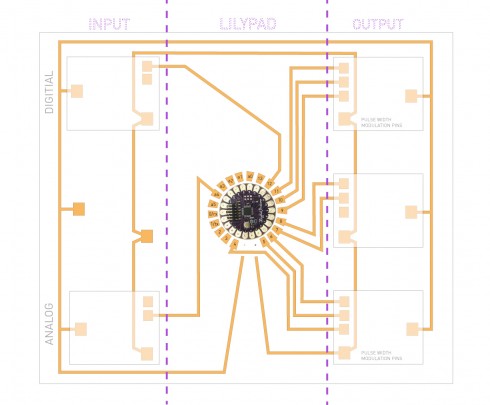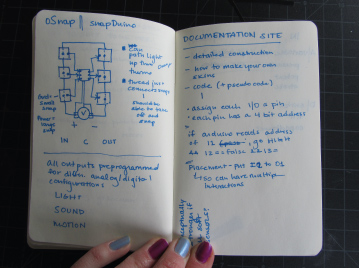SnapToTrace Research References (with some links!)
REFERENCES
REFERENCES
With links to resources
Eisenberg, M. and Buechley, L. (2008). Pervasive Fabrication: Making Construction Ubiquitous in Education. Upcoming in Journal of Software. (Invited submission)
Klemmer, S. and Landay, J. (2009). Toolkit Support for Integrating Physical and Digital Interactions. Human-Computer Interaction, vol 24, pp.315-366.
Marcu, G., Kaufman, S.J., Lee J.K., Black, R.W., Dourish, P., Hayes, G.R., Richardson, D.J. Design and Evaluation of a Computer Science and Engineering Course for Middle School Girls. In Proceedings of SIGCSE, 2010.
Rusk, N., Resnick, M., Berg, R., & Pezalla-Granlund, M. (2008). New Pathways into Robotics: Strategies for Broadening Participation. Journal of Science Education and Technology, vol. 17, no. 1, pp. 59-69.
Schweikardt, E. and Gross, M. (2009). Designing Systems to Design Themselves. In Proceedings of SIGCHI, Boston, Massachusetts, USA, April 2009.
Wyeth, P. [2008] How Young Children Learn to Program with Sensor, Action, and Logic Blocks. Journal of the Learning Sciences, 17:4
SnapToTrace Final Paper
This paper is in SIGCHI format and was written for submission to the SIGCHI Conference on Tangible Embedded, Embodied Interaction 2012. You can download it here.
ABSTRACT
Modular toolkits and electronic textiles have emerged as highly effective resources to engage new audiences in computational learning. This paper will briefly review past relevant research in these domains, paying close attention to different taxonomies that consider the role of personal fabrication. Based on this analysis and user research, I will then introduce an interface prototype that is pedagogically concerned with user scalability and multiple points of entry. A specific focus is placed on the role materials play in achieving these pedagogical goals. I will close with plans for future iterations of the circuit mat and possible directions for development.
SnapToTrace Final Presentation and Feedback

Final Presentation located here.
The feedback I received from Melanie focused mainly on developing the board as an interface to systems learning in realms outside of computation. This was fantastic feedback, especially since an early concept had framed it in this way. Katherine’s feedback was continued simplification of the components by taking them off the board. This is definitely the goal of the summer moving this project into potential thesis territory, along with some logic-based components.
Minithesis Prototypes: Round 2

I got a little stuck over the weekend and earlier this week as I began to really shape my concept. With each new major project I am increasingly learning the indeterminate nature of my process; it certainly requires much unyielding percolation followed by periods of rapid action.
Slowly I am meandering my way towards a hard schematic, metaphorically speaking, of realizing my concept, especially after the feedback I received from my group.
Major Studio Prototype Presentation
More documentation to come, but here is the presentation.
Major Studio Final Project Concept
Tentative Title
Does Not Compute: An Investigation into Computational Points of Entry for Middle/High School Students
Concept
For my final project, I am going to compose a curriculum aimed at introducing middle to high school students to basic electronic, programming, and design concepts through soft circuits and a create a body of compiled and personal research surrounding this sphere.
Deliverables
As of right now I am still in the process of fully flushing this out, but I will include some or all of the following:
Big Ideas
This final project is the intersection of two recent conceptual preoccupations and a recent experience at a girl’s after school session at Quest to Learn. The first preoccupation centers directly on the mystification, or demystification, of technology. The second is the idea of a point of entry, specifically regarding technology.
Background
As for the third, I have recently been interning at Quest to Learn’s Short Circuit after school program. I usually go on Thursdays when the dominant population are 6th and 7th grade boys, along with one girl who I have been working with a variety of independent projects on. Over spring break, however, I had the chance to help plan and run the Girlz Jam (I have class at this time otherwise, much to my chagrin) in which a group of ten 7th grade girls come together for a 2 hour after school session centered around a weekly topic. I should mention that the goal of this program is specifically to encourage female after school participation by creating a shared creative space, especially since at this time in development, blurry elementary school gender lines begin to focus quite sharply.
While I have had experience running after school before, this session was quite unfocused and largely dictated by the girls with the organizers acting more like herders. First and foremost, I must say that after school is hard – students have just had a long day of school and really just want to listen to music and text their friends. Secondly, teaching soft circuits is extremely difficult: it requires a rewiring of your brain around both sewing and circuitry, not an easy feat especially for those who are novices to both. In spite of this, the potential was palatable enough for me to continue thinking about it for the past five days, and brought back previous work I had done in curriculum design and interaction design in spaces of learning. For me, the design problems that arise in these areas are fascinating. Combine that with the masochistic satisfaction of working with soft circuits and e-textiles, the intersection of these domains is endlessly stimulating.
The “WHY” and Audience
Based on countless studies and statistics, bodies of research, and simple observation or questioning, computation is a realm that most of the population feels estranged from, largely due to (as I will posit for a thesis) a psychological barrier resulting from lack of exposure or disinterest in the components that they traditionally associate with programming and physical computing.
It feels trite to state the following, but its significance cannot be underscored enough: students must have more exposure to and experience with working with various technologies. This is for a variety of reasons that we have all heard before – international competition, job preparation, etc – but for this project, I will assume these as established propositions and posit that engaging youth with this type of process is innovative in its inherent ability to unlock creative potential by challenging preconceptions of materials, processes, and the cultural milieu traditionally associated with them.
Further Concepts to Incorporate
I would like this project to have an open source focus. Open source movements are in full swing and are going to play a massive role in defining culture, economics, politics – life in general – in the coming years. Following from this, as technology has become more and more accessible, a significantly large portion of the public have undergone a transformation from consumer to producer. (I would like to note, however, that these roles are not binary and there is much grey space to be exploited in between.) By making youth more aware of the individual and collective benefits of open source and the communities surrounding it, they will be more likely to actively contribute, thereby both sharing knowledge and reinforcing their own.
Article: Why does the US fail in science education?
In thinking about the idea of creating an interactive book of psuedocode for mini-thesis, this article is hits upon one of the main reasons why science and math (re: coding) have such an inaccessible point of entry for most people:
“That notion — that you either have the gift or you don’t — “is particularly damaging in science because the reality of science is you’re basically always failing,” said Mr. Pellathy, who has a Ph.D. in physics.”
It mentions numerous other factors as well, but this is a key point that strikes people at a psychological level: if this is not overcome, further learning is easily disarmed. While my audience is not necessarily going to be K-12 or novice coders, this article hits the foundation of why most people have trepidation when approaching code in general.
Also, this will be the first of many articles I will post in an attempt to get all my research in one place. Here’s to it: http://www.post-gazette.com/pg/11079/1133328-84.stm





